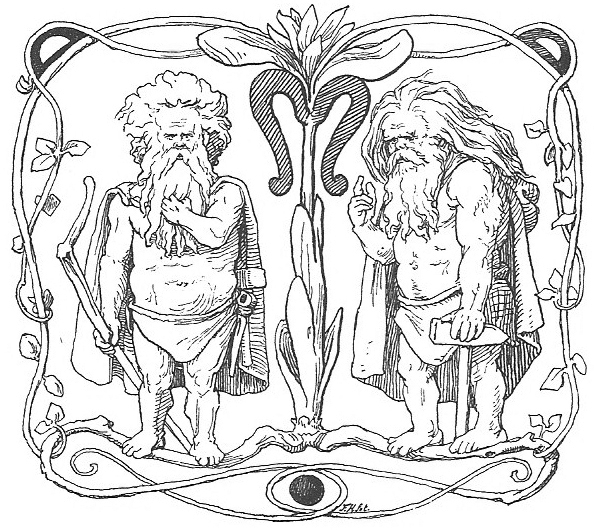No, don't think so. The earliest usage of the term I could find from the OED used in a modern medical context was from 1865.
Originating from Old English and Proto-Germanic, dwarf means a very short human or supernatural being; verb form means to stunt growth or make something appear sm...

www.etymonline.com
As I said, the Old English use of the word goes back to 700. This predates the mythological use from any culture. And the usage of that term associated with medical illness (as human dwarfs are often deformed) goes back just as far.
It would be an interesting question to pose to an academic whether or not the dwarfs in "Little Snow White" were originally intended to be part of a separate race, or merely humans. Normally I wouldn't care. But the reason it suddenly becomes interesting to me in the context of this thread is because of Peter Dinklage. After all, I read the post with his comments from the podcast where he is ranting about this primitive old tale being retold. Yet if Snow White's dwarfs were part of the mythological race of dwarfs, how is it offensive? Is he also offended by Rumpelstiltskin?
The earliest mythological use of the term was in Scandinavian folklore from the 1200's and 1300's. There was a particular tradition within that where they were dark and shadowy supernatural creatures, associated with elves, which I'm assuming is the inspiration for AD&D creatures like the dark elves which ironically don't resemble them. In fact, apparently Grimm surmised that dwarfs were the original dark half after a mythological splintering of a "proto-elf". Most on Sherdog might recognize dark elves because of how Marvel reimagined them in the origin story of Loki, also drawn from Norse mythology, in the second
Thor movie. I'm assuming this is the mythological source of what would later become Goethe's
Erlkonig; the Erlking is a dark supernatural spirit, a fairy, a wood elf. This is a tale of a dark elf I think most of us might recognize in that tradition. But it wasn't the only tradition. There were others.
The mythology trickled down into mainland Europe and Germanic myth. The OED mentions:
b.A.1.b One of a supposed race of diminutive beings, who figure in Teutonic and esp. Scandinavian mythology and folk-lore; often identified with the elves, and supposed to be endowed with special skill in working metals, etc.
This would seem to match the dwarfs from Snow White. Not necessarily supernatural. But a different race, yes.
You'll also notice on the Ety page Grimm himself quoted from his
Teutonic Mythology describing how this mythological race of dwarfs shrunk from mankind, and represented a sort of lingering spirit of naturalism resisting civilization-- technology, urban development, and Christianity-- but not necessarily in a malevolent way. He wasn't referencing the dwarfs in Snow White in that passage, but they fit at least in the sense that they were hermits in the hills. I found another reference to dwarfs in Grimm's work that jives with them:
"With our people a favourite mode of representing translation is to shut up the enchanted inside a mountain, the earth, so to
speak, letting herself be opened to receive them. More than one idea may be at work here together: motherly earth hides the
dead in her bosom, and the world of souls is an underground world; elves and dwarfs are imagined living inside mountains, not so much in the depths of the earth as in hills and rocks that rise above the level ground; but popular forms of cursing choose
all manner of phrases to express the very lowest abyss."
They also build a crystal sarcophagus for Snow White which isn't metal, but would be similar to how they fashioned fine jewelry as the four dwarves did the
Brisingamen for Freya which is a tale that seems to have deeply fascinated Jakob Grimm.
On the other hand, consider that there was a Russian tale drawn from their own early oral traditions that is almost identical to Little Snow White. You have to wonder if the tale traveled, and spanned continents. In this version, like in Little Snow White, the seven men are also not supernatural, and not dwarfs at all, but bogatyrs, or knights-errant:

en.wikipedia.org
In so many ways they're not at all like most dwarfs I've ever known from Germanic myth. There's shitloads of old tiny creatures in German myth: dwarfs, imps, kobolds, gnomes, sprites, goblins, and many others by many other names, often used interchangeably. They always seem to be little shits. Almost always they're mischievous, or tricksters, sometimes they're downright evil. Often they inhabit homes or castles. They steal or kill children. They take what's dearest to you. They meddle with what you love, they undo your toil. They revel in tormenting us mortals. You'll notice on the Ety page the mention of gnomes springing from the same dwarf root, in Swiss & Germanic folklore, who were garden dwellers, and inspired those ceramic little statues we know today.
They're not at all like the dwarfs in Snow White. Which might suggest that the Russian tale predated the Germanic tale, orally, where they weren't dwarfs at all. Maybe it all got enmeshed and embellished.






